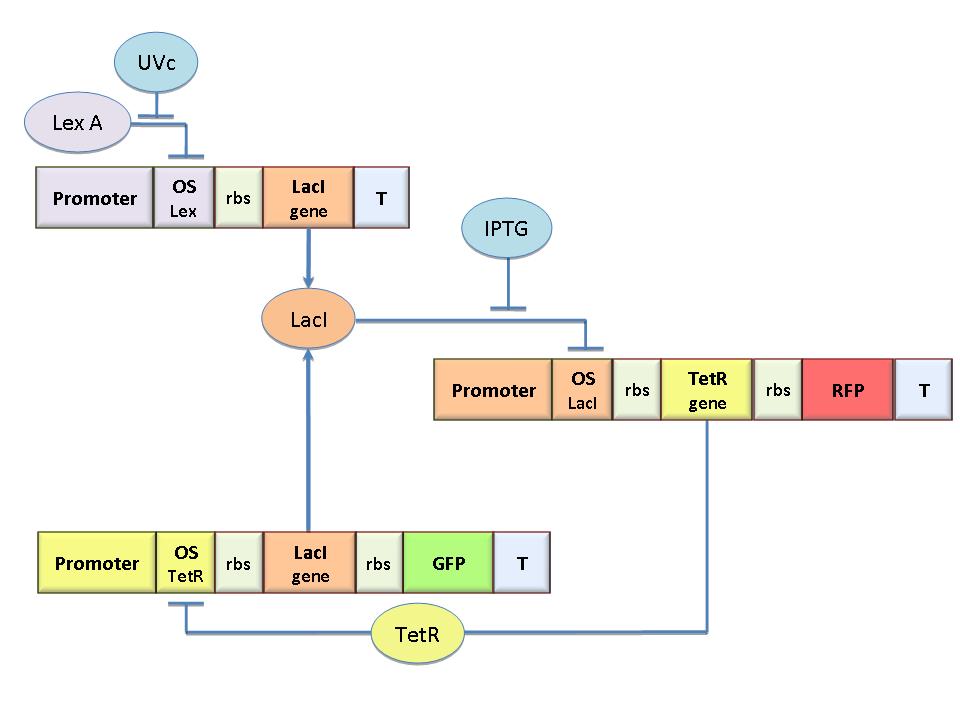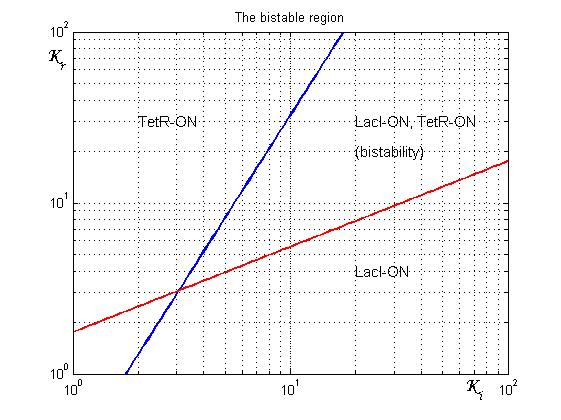Team:Bologna/Project
From 2008.igem.org
(→Ecoli.PROM: an Erasable and Programmable Genetic Memory in E. coli) |
(→Ecoli.PROM: an Erasable and Programmable Genetic Memory in E. coli) |
||
| Line 38: | Line 38: | ||
The molecular circuit in Figure 1 can switch between two different stable states (LacI-ON and TetR-ON), driven by two external stimuli (UVc and IPTG). | The molecular circuit in Figure 1 can switch between two different stable states (LacI-ON and TetR-ON), driven by two external stimuli (UVc and IPTG). | ||
| - | We denominated it a Flip-Flop since it works as a SR Latch: LacI state is the Image:q.jpg output and TetR state is the Image:qneg.jpg output. Uvc is the set signal and IPTG is the reset signal. Indeed, IPTG stimulation inhibits LacI repressor, thus can cause the transition from the LacI-ON state to the TetR-ON. UVc radiation, inactivating LexA repressor through the SOS response [Friedberg et al. 1995] can cause the opposite transition from LacI-ON to TetR-ON. | + | We denominated it a Flip-Flop since it works as a SR Latch: LacI state is the [[Image:q.jpg]] output and TetR state is the [[Image:qneg.jpg]] output. Uvc is the set signal and IPTG is the reset signal. Indeed, IPTG stimulation inhibits LacI repressor, thus can cause the transition from the LacI-ON state to the TetR-ON. UVc radiation, inactivating LexA repressor through the SOS response [Friedberg et al. 1995] can cause the opposite transition from LacI-ON to TetR-ON. |
The core elements of the genetic program are two mutually regulated promoters. The transcriptional strength and the repressor binding affinity determinate such relevant circuit properties as the bistability and the response to inputs. | The core elements of the genetic program are two mutually regulated promoters. The transcriptional strength and the repressor binding affinity determinate such relevant circuit properties as the bistability and the response to inputs. | ||
Revision as of 01:25, 30 October 2008
| HOME | PROJECT | TEAM | SOFTWARE | MODELING | WET LAB | LAB-BOOK | SUBMITTED PARTS | BIOSAFETY AND PROTOCOLS |
|---|
Contents |
Ecoli.PROM: an Erasable and Programmable Genetic Memory in E. coli
The specific goal of our project was to design a bacterial reprogrammable memory, i.e. colonies of genetically engineered E. coli immobilized in solid medium where they work as an array of binary memory cells.
To engineer the bacteria we designed a modular genetic Flip-Flop composed of two parts (Figure 1): a binary memory block and an induction block, sensitive to UV radiation, to set LacI ON. UV has been chosen to have a fine spatial selectivity in programming the memory cells, whereas IPTG should be used to reset the entire memory (TetR ON).
The core elements of the genetic memory are two mutually regulated promoters, each designed as indipendent operator sites flanking a constitutive promoter. In this way, the promoter transcriptional strength and the repressor binding affinity can be independently fixed. To this aim we designed operator libraries for LacI, TetR, Lambda and LexA repressors, cloning them in the BioBrick format for their standard assembly. This allowed us to design and assemble three different circuits, where the BBa_J23118 constitutive promoter was cloned with the Lac operator 1, the Lac operator 2 and the symmetric one from the Lac operator library. Moreover, LacI was cloned downstream of the promoter- operator sequence and the GFP was chosen as the reporter. Thus, promoter activation was under the control of the LacI repressor, and each of the circuits was expected to yield a specific promoter repression/activation profile depending on the characteristic operator- repressor binding affinity. The model-based analysis of the circuit response was used for the Ki transcription index determination and the design of the desired promoter/ operator couple needed to achieve bistability.
Introduction
The molecular circuit in Figure 1 can switch between two different stable states (LacI-ON and TetR-ON), driven by two external stimuli (UVc and IPTG).
We denominated it a Flip-Flop since it works as a SR Latch: LacI state is the ![]() output and TetR state is the
output and TetR state is the ![]() output. Uvc is the set signal and IPTG is the reset signal. Indeed, IPTG stimulation inhibits LacI repressor, thus can cause the transition from the LacI-ON state to the TetR-ON. UVc radiation, inactivating LexA repressor through the SOS response [Friedberg et al. 1995] can cause the opposite transition from LacI-ON to TetR-ON.
The core elements of the genetic program are two mutually regulated promoters. The transcriptional strength and the repressor binding affinity determinate such relevant circuit properties as the bistability and the response to inputs.
output. Uvc is the set signal and IPTG is the reset signal. Indeed, IPTG stimulation inhibits LacI repressor, thus can cause the transition from the LacI-ON state to the TetR-ON. UVc radiation, inactivating LexA repressor through the SOS response [Friedberg et al. 1995] can cause the opposite transition from LacI-ON to TetR-ON.
The core elements of the genetic program are two mutually regulated promoters. The transcriptional strength and the repressor binding affinity determinate such relevant circuit properties as the bistability and the response to inputs.
As shown in Figure 2, the coexistence of two stable equilibria (LacI-ON and TerR-ON) is guaranteed for![]() , LacI transcription rateo, and
, LacI transcription rateo, and ![]() , TetR transcription rateo, greater than 3 in a large range of values (bistability range). Imposing a value for
, TetR transcription rateo, greater than 3 in a large range of values (bistability range). Imposing a value for ![]() greater than 3 it is possible to establish a range for
greater than 3 it is possible to establish a range for ![]() to have a bistable behaviour. More the (
to have a bistable behaviour. More the (![]() ,
,![]() ) point is near the bifurcation lines more the transition from bistability to monostability is probably. To have a good robustness we fixed
) point is near the bifurcation lines more the transition from bistability to monostability is probably. To have a good robustness we fixed ![]() and
and ![]() equal to 10. For this value the circuit is sufficently distant from the bifurcation lines to evoid random memory switching but it is possible to set (or to reset) the memory with proper stimulation.
equal to 10. For this value the circuit is sufficently distant from the bifurcation lines to evoid random memory switching but it is possible to set (or to reset) the memory with proper stimulation.
Since the Registry lacks independent transcriptional regulation elements that could allow the design of a promoter with the desired transcriptional strenght/repression rateo needed for bistability, we decided to introduce operator site elements.
Thus, we synthesized four libraries of operator sequences, respectively for [http://partsregistry.org/wiki/index.php?title=Part:BBa_K079045 LacI], [http://partsregistry.org/wiki/index.php?title=Part:BBa_K079046 TetR], [http://partsregistry.org/wiki/index.php?title=Part:BBa_K079047 cI] and [http://partsregistry.org/wiki/index.php?title=Part:BBa_K079048 LexA] repressor proteins ([http://partsregistry.org/wiki/index.php?title=Part:BBa_K079045 see details]). In each library, there are three sequences each with a different repressor binding affinity to the repressor protein.
We design three genetic circuits where the same promoter assembled with the three Lac operators was under the control of the LacI repressor (closed- loop). GFP was chosen as the reporter. The value of ![]() -index can be identified comparing the experimental responses of the open loop, without the operator site, and closed loop circuits.
-index can be identified comparing the experimental responses of the open loop, without the operator site, and closed loop circuits.
We finally assembled only one of the three circuits containing the weaker Lac operator site (Lac operator 2).
We introduce the ratio ![]() between the fluorescence in open loop and in closed loop.
between the fluorescence in open loop and in closed loop.
After measuring the ratio ![]() it is possible to calculate
it is possible to calculate ![]() and then it is possible to establish the
and then it is possible to establish the ![]() range that guarantees bistability. In the presence of an experimentally characterized library of regulated promoter, the procedure can be adopted to design genetic Flip-Flops with desired behaviors.
range that guarantees bistability. In the presence of an experimentally characterized library of regulated promoter, the procedure can be adopted to design genetic Flip-Flops with desired behaviors.
Conclusions
This will allow the rational design of regulated promoter elements that are still lacking in the Registry.
This approach has been applied in the building of our UV-programmable memory, and we expect it to be a general benefit in a larger number of applications in Synthetic Biology.
Collaboration with other iGEM2008 Teams
- After the last year competition, at the beginning of the 2008, we decided to get a new team started for iGEM2008 competition. In April, we got in contact with Prof. Paolo Magni, who wanted to start a new team in Pavia for iGEM2008. So, in order to share experiences and ideas about iGEM, and to show him what kind of wet lab resources are necessary to develop a Synthetic Biology project, we met at the Cellular and Molecular Engineering Laboratory of the University of Bologna- Cesena Campus. After this first meeting, there have been other chances to meet during the summer. In particular, several conference calls were organized and two meetings were scheduled in Pisa and Bressanone (Italy). It was fundamental to compare lab protocols and techniques to help each other avoiding mistakes and speeding up project progress. The main topics of our discussion were the optimization of plasmid resuspension and ligation reaction steps as well as how to measure fluorescence. Finally, before DNA Repository quality control publication on the Registry web site, we cross-checked some parts that showed problems after DNA transformation. Problems had been confirmed by quality control results (parts' sequences classified as "inconsistent").
- We want even to mention the courtesy of the Valencia iGEM Team, that have advised us about the critical use of GFP and RFP at the same time.
Concluding the iGEM 2007 Project
In the iGEM 2007 we used the LacY gene (BBa_J2210) to design a genetic Schmitt trigger. Since this part was not working well, we sent it to be sequenced and found that it contained a 35 bp insertion upstream the endogenous LacY gene sequence. This insertion probably caused a frameshift in protein translation, making the gene ineffective. So, we amplified the right gene sequence and put it in the BioBrick format. Successive sequencing confirmed the right assembling of this part. We also measured IPTG-induced fluorescence in the genetic Schmitt trigger (see Figure) and we assessed the correct function of the new LacY part. To contribute to Registry’s improvement we decided to send this new part to the Registry ([http://partsregistry.org/Part:BBa_K079015 K0790015]).

 "
"



